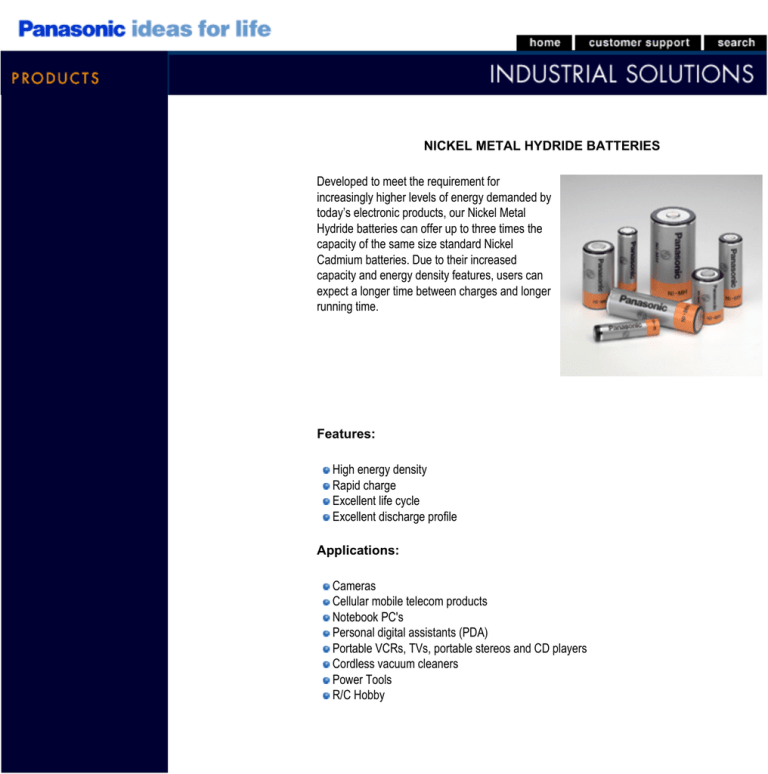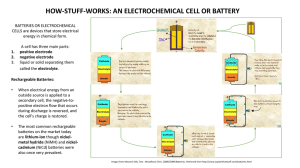Panasonic Nickel Metal Hydride Batteries (NiMH)
advertisement

NICKEL METAL HYDRIDE BATTERIES Developed to meet the requirement for increasingly higher levels of energy demanded by today’s electronic products, our Nickel Metal Hydride batteries can offer up to three times the capacity of the same size standard Nickel Cadmium batteries. Due to their increased capacity and energy density features, users can expect a longer time between charges and longer running time. Features: High energy density Rapid charge Excellent life cycle Excellent discharge profile Applications: Cameras Cellular mobile telecom products Notebook PC's Personal digital assistants (PDA) Portable VCRs, TVs, portable stereos and CD players Cordless vacuum cleaners Power Tools R/C Hobby Technical Data Rapid Dimensions Minimum Charge Nominal Capacity Voltage Diameter Height (1/5C) Current Hours (V) inch inch (mAh) (mA) (h) (mm) (mm) Approximate Weight oz (g) Model No. Size HHR60AAAH1 AAA 1.2 500 250 2.4 0.41+0/-0.03 (10.5+0/-0.7) HHR70AAAJ AAA 1.2 720 650 1.2 0.41+0/-0.03 1.75+0/-0.04 (10.5+0/-0.7) (44.5.0+0/-1.0) 0.46 (13) HHR75AAA/B AAA 1.2 700 450 1.7 0.41+0/-0.03 (10.5+0/-0.7) 1.75+0/-0.04 (44.5+0/-1.0) 0.42 (12) HHR120AA 4/5AA 1.2 1150 1200 1.2 0.57+0/-0.03 (14.5+0/-0.7) 1.69+0/-0.04 (43.0+0/-1.0) 0.81 (23) HHR150AA AA 1.2 1500 1500 1.2 0.57+0/-0.03 (14.5+0/-0.7) 1.97+0/-0.04 (50.0+0/-1.5) 0.92 (26) HHR210AA/B AA 1.2 2000 1200 2 0.57+0/-0.3 (14.5+0/-0.7) 1.99+0/-0.5 (50.5+0/-1.0) 1.02 (29) HHR200A 4/5A 1.2 2000 2000 1.2 0.67+0/-0.03 (17.0+0/-0.7) 1.69+0/-0.06 (43.0+0/-1.5) 1.13 (32) HHR210A A 1.2 2100 2100 1.2 0.67+0/-0.03 (17.0+0/-0.7) 1.97+0/-0.06 (50.0+0/-1.5) 1.34 (38) HHR210AH1 A 1.2 1900 ----- ----- 0.67+0/-0.03 (17.0+0/-0.7) 1.97+0/-0.06 (50.0+0/-1.5) 1.34 (38) HHR370AH1 18670 (L-fat-A) 1.2 3500 ----- ----- 0.72+0/-0.03 (18.2+0/-0.7) 2.64+0/-0.06 (67.0+0/-1.5) 2.12 (60) HHR330APH 18670 (L-fat-A) 1.2 3200 1650 2.4 0.72+0/-0.03 (18.2+0/-0.7) 2.64+0/-0.06 (67.0+0/-1.5) 2.12 (60) HHR380A2 L-A 1.2 3700 2000 2.3 0.67+0/-0.03 (17.0+0/-0.7) 2.64+0/-0.06 (67.0+0/-1.5) 1.87 (53) HHR450A2 18670 (L-fat-A) 1.2 4200 2000 2.7 0.72+0/-0.03 (18.2+0/-0.7) 2.64+0/-0.06 (67.0+0/-1.5) 2.12 (60) HHR200SCP3 4/5SC 1.2 1900 2000 1.2 0.91+0/-0.04 (23.0+0/-1.0) 1.34+0/-0.06 (34.0+0/-1.5) 1.50 (42) 1.75+0/-0.04 (44.5+0/-1.0) 0.42 (12) HHR250SCH1 SC 1.2 2500 1250 2.4 0.91+0/-0.04 (23.0+0/-1.0) 1.69+0/-0.06 (43.0+0/-1.5) 1.94 (55) HHR260SCP SC 1.2 2600 2450 1.2 0.91+0/-0.04 (23.0+0/-1.0) 1.69+0/-0.06 (43.0+0/-1.5) 1.94 (55) HHR300SCP3 SC 1.2 2800 3000 1.2 0.91+0/-0.04 (23.0+0/-1.0) 1.69+0/-0.06 (43.0+0/-1.5) 1.95 (55) HHR300CH1 C 1.2 3300 3100 2.4 1.02+0/-0.04 (25.8+0/-1.0) 1.97+0/-0.06 (50.0+0/-1.5) 2.82 (80) HHR650D3 D 1.2 6500 6500 1.2 1.30+0/-0.04 (33.0+0/-1.0) 2.39+0/-0.08 (60.8+0/-2.0) 6.0 (170) HHR900D D 1.2 8250 4500 2.4 1.30+0/-0.04 (33.0+0/-1.0) 2.39+0/-0.08 (60.8+0/-2.0) 5.82 (165) 1 H Type: Improved low rate charge characteristics at higher temperatures. Ideal for back-up applications (with appropriate charge control circuitry). 2 Mainly for PC applications. 3 Mainly for High Drain Applications such as Power Tools. NICKEL METAL HYDRIDE BATTERIES: INDIVIDUAL DATA SHEET Typical Discharge Characteristics HHR900D Cylindrical D size (HR 33/62) Dimensions (with Tube) (mm) 1.6 Charge: 825mA(0.1 It)x16hrs,20˚C Disharge Temperature: 1650mA(0.2It), 20˚ Voltage (V) 1.4 1.2 1.0 0.8 33.0 +- 01.0 0.6 (+) 0.4 0 2000 4000 6000 8000 10000 Capacity (mAh) 61 +- 01.5 1.6 Charge: 825mA(0.1It)x16hrs, 20˚C Disharge Temperature: 1650mA(0.2It), 20˚ Voltage (V) 1.4 ( ) Specifications inch Diameter 33.0+0/-0.1 1.3+0/-0.04 Height 61.0+0/-1.5 2.40+0/-0.08 Approximate Weight Grams 170 Ounces 6.0 1.2V 1.6 9000 mAh 1.4 Rated (Min.) 8250 mAh 1.2 Ambient Temperature Standard 900mA (0.1It) x 16hrs. Rapid 4500mA (1It) x 2.4 hrs. Standard Rapid3 Discharge Storage 3.5mΩ < 1 year < 6 months ˚C 0˚C to 45˚C 0˚C to 40˚C -10˚C to 65˚C -20˚C to 35˚C -20˚C to 45˚C ˚F 32˚F to 113˚F 32˚F to 104˚F 14˚F to 149˚F -4˚F to 95˚F -4˚F to 113˚F 0 2000 4000 6000 8000 10000 Capacity (mAh) Average2 Approx. Internal impedance at 1000Hz at charged state. Charge 0.8 0.4 Voltage (V) Nominal Voltage Charge 1.0 0.6 mm Discharge Capacity1 1.2 Charge: 825mA(0.1It)x16hrs, 20˚C Disharge Temperature: 8250mA(1It), 20˚ 1.0 0.8 0.6 0.4 0 2000 4000 6000 8000 10000 Capacity (mAh) 1 After charging at 0.1It for 16 hours, discharging at 0.2It. For reference only. 3 For rapid charge: contact Panasonic for recommended charge control methods. Battery performance and cycle life are strongly affected by how they are used. In order to maximize battery safety, please consult Panasonic when determining charge / discharge specs, warning label contents and unit design. 2 Note: [It] was previously expressed as [C]. [It] is an IEC standard expression for the amount of charge or discharge current and is expressed as: It(A) = Cn (Ah)/1h. • [It] is the reference test current in ampres • [Cn] is the rated capacity of the cell or battery in Ampere-hours. n = the time base [hours] for which the rated capacity is declared NICKEL METAL HYDRIDE HANDBOOK AUGUST 2005 This information is generally descriptive only and is not intended to make or imply any representation, guarantee or warranty with respect to any cells and batteries. Cell and battery designs/specifications are subject to modification without notice. Contact Panasonic for the latest information. NICKEL METAL HYDRIDE BATTERIES High-energy Batteries to Launch a New Era of Products Overview Construction As electronic products have come to feature more sophisticated functions, more compact sizes and lighter weights, the sources of power that operate these products have been required to deliver increasingly higher levels of energy. To meet this requirement, nickel-metal hydride batteries have been developed and manufactured with nickel hydroxide for the positive electrode and hydrogenabsorbing alloys, capable of absorbing and releasing hydrogen at high-density levels, for the negative electrode. Because Ni-MH batteries have about twice the energy density of Ni-Cd batteries and a similar operating voltage as that of Ni-Cd batteries, they have become a mainstay in rechargeable batteries. Nickel-metal hydride batteries consist of a positive plate containing nickel hydroxide as its principal active material, a negative plate mainly composed of hydrogen-absorbing alloys, a separator made of fine fibers, an alkaline electrolyte, a metal case and a sealing plate provided with a self-resealing safety vent. Their basic structure is identical to that of Ni-Cd batteries. With cylindrical nickel-metal hydride batteries, the positive and negative plates are seperated by the separator, wound into a coil, inserted into the case, and sealed by the sealing plate through an electrically insulated gasket. NICKEL METAL HYDRIDE HANDBOOK, PAGE 7 AUGUST 2005 NICKEL METAL HYDRIDE BATTERIES - CONTINUED Features Five Main Characteristics • Similarity with Ni-Cd batteries These batteries have similar discharge characteristics to those of Ni-Cd batteries. • Double the energy density of conventional batteries Nickel-metal hydride batteries have approximately double the capacity compared with Panasonic’s standard Ni-Cd batteries. As with Ni-Cd batteries, nickel-metal hydride batteries have five main characteristics: charge, discharge, storage life, cycle life and safety. 1) Charge characteristics Like Ni-Cd batteries, the charge characteristics of nickelmetal hydride batteries are affected by current, time and temperature. The battery voltage rises when the charge current is increased or when the temperature is low. The charge efficiency differs depending on the current, time, temperature and other factors. Size: Charge: Discharge: Temperature: Voltage (V) 1.6 KR17/43 1CmA x 1.2h 0.2CmA 20˚C 1.4 1.2 1.0 P-120AS Ni-Cd HHR200A Ni-MH 0.8 0 200 400 600 800 1000 1200 1400 1600 1800 2000 Discharge Capacity (mAh) • Cycle life equivalent to 500 charge and discharge cycles Like Ni-Cd batteries, nickel-metal hydride batteries can be repeatedly charged and discharged for about 500 cycles. (example: IEC charge and discharge conditions) • Rapid charge in approx. 1 hour Nickel-metal hydride batteries can be rapidly charged in about an hour using a specially designed charger. • Excellent discharge characteristics Since the internal resistance of nickel-metal hydride batteries is low, continuous high-rate discharge up to 3CmA is possible, similar to Ni-Cd batteries. Charge characteristics 2.0 Ni-MH 1.6 1.2 0.6 0 20 40 60 80 100 120 160 Charge temperature characteristics at 1It charge Charge : 1CmA x 120% Model : HHR200A 1.8 0˚C 20˚C 40˚C 1.6 Voltage (V) P-120AS Ni-Cd 140 Charge Capacity (%) (Nominal Capacity Ratio) 2.0 800 1.4 1.2 1.0 600 400 0 1.4 0.8 1400 1000 1It 0.33It 0.1It 1.0 1600 1200 Charge : 120% Temperature: 20˚C Model : HHR200A 1.8 Size: HR17/43 Charge: 1CmA x 1.2h Temp.: 20˚C 2000 HHR200A Capacity (mAh) • • 2200 1800 Nickel-metal hydride batteries should be charged at a temperature ranging from 0°C to 40°C using a constant current of 1It or less. The charge efficiency is particularly good at a temperature of 10°C to 30°C. Repeated charge at high or low temperatures causes the battery performance to deteriorate. Furthermore, repeated overcharge should be avoided since it will downgrade the battery performance. Refer to the section on recommended charge methods for details on how to charge the batteries. Voltage (V) 1.8 0.8 1 2 3 Discharge Current (A) 4 5 0.6 0 20 40 60 80 100 120 140 160 Charge Capacity (%) (Nominal Capacity Ratio) NICKEL METAL HYDRIDE HANDBOOK, PAGE 9 AUGUST 2005


